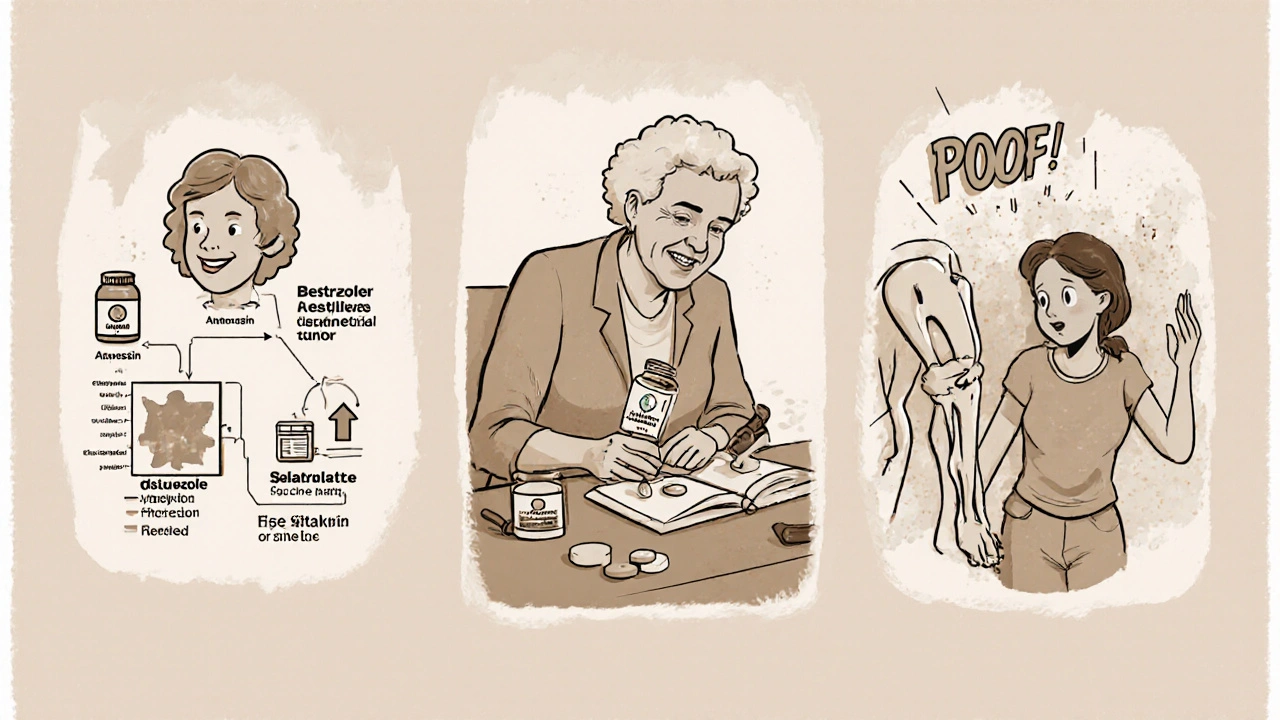Aromatase Inhibitor Decision Tool
Select your patient characteristics to receive a personalized recommendation for aromatase inhibitor therapy.
This tool helps match the right treatment based on clinical factors discussed in the article.
Recommended Treatment
Key Considerations
Potential Benefits
Potential Side Effects
When doctors need to lower estrogen for hormone‑responsive breast cancer, they reach for a class of drugs called aromatase inhibitors. Aromasin (Exemestane) is a steroidal inhibitor that shuts down the aromatase enzyme irreversibly, meaning it binds permanently and forces the body to keep estrogen levels low.
But Aromasin isn’t the only option on the market. Letrozole and Anastrozole are non‑steroidal competitors, while drugs like Tamoxifen work through a different mechanism entirely. Knowing when to pick one over another can feel like a maze, especially when side‑effect profiles, dosing schedules, and patient characteristics vary.
Why the comparison matters
- Patients and caregivers want to understand which drug offers the best balance of efficacy and tolerability.
- Oncologists must match the inhibitor to the disease stage, menopausal status, and other concurrent meds.
- Insurance formularies and Australian PBS listings can make cost a deciding factor.
Below we break down the most common alternatives, show how they stack up against Aromasin, and give practical tips for choosing the right one.
Core attributes of each inhibitor
| Brand / Generic | Mechanism | Typical dose | Half‑life | Common side‑effects |
|---|---|---|---|---|
| Aromasin (Exemestane) | Irreversible steroidal inhibitor | 25mg once daily | ~24hours | Joint pain, hot flashes, fatigue |
| Letrozole (Femara) | Reversible non‑steroidal inhibitor | 2.5mg once daily | ~2days | Bone loss, nausea, insomnia |
| Anastrozole (Arimidex) | Reversible non‑steroidal inhibitor | 1mg once daily | ~50hours | Joint stiffness, dizziness, rash |
| Tamoxifen (Nolvadex) | Selective estrogen receptor modulator (SERM) | 20mg daily | ~7days | Thromboembolism, uterine polyps, hot flashes |
Mechanistic differences that shape outcomes
The key distinction is whether the drug is steroidal (Aromasin) or non‑steroidal (Letrozole, Anastrozole). Steroidal agents mimic the natural substrate of aromatase and bind covalently, leading to permanent deactivation until the body synthesizes new enzyme. This can translate into slightly stronger estrogen suppression, which some clinicians prefer for high‑risk or metastatic cases.
Non‑steroidal inhibitors compete reversibly, so their effect wanes more quickly if the medication is stopped. They tend to have a smoother side‑effect curve, making them popular for adjuvant therapy after surgery.
Tamoxifen, by contrast, blocks estrogen receptors in breast tissue while acting as an estrogen agonist in bone and uterus. It’s often used when patients cannot tolerate aromatase inhibition or when a mixed‑modality approach is needed.
Who benefits most from each option?
Postmenopausal women with estrogen‑receptor‑positive (ER⁺) breast cancer are the primary candidates for aromatase inhibitors. Within this group, certain scenarios tip the scales:
- High‑risk disease or metastatic spread: Many oncologists favor Aromasin because its irreversible binding can achieve deeper estrogen depletion.
- Concern about bone health: Letrozole and Anastrozole both accelerate bone loss. In patients with osteoporosis, clinicians might choose Tamoxifen for its protective effect on bone, or add bisphosphonates alongside the inhibitor.
- History of joint pain: Non‑steroidal agents are notorious for arthralgia. If a patient reports severe joint aches on Letrozole, switching to Aromasin or lowering the dose can provide relief.
- Drug‑interaction profile: Aromasin is metabolized primarily by CYP3A4. Patients on strong CYP3A4 inducers (e.g., certain antiepileptics) may need dose adjustments, whereas Letrozole and Anastrozole have less pronounced interactions.

Side‑effect nuance and management
All aromatase inhibitors lower estrogen, so hot flashes, night sweats, and mood swings are common across the board. However, the intensity differs:
- Joint and muscle pain: Reported in up to 30% of patients on Letrozole and Anastrozole. Physical therapy and occasional NSAIDs can help. Aromasin’s joint pain rate is slightly lower, around 20%.
- Bone mineral density (BMD) loss: Letrozole shows the steepest decline, roughly 5% per year without prophylaxis. Anastrozole is a close second. Aromasin’s impact on BMD is modest but still warrants calcium, vitaminD, and possible bisphosphonate therapy.
- Fatigue: More prevalent with Aromasin in the first three months, usually improves with continued use.
- Gynecologic issues: Tamoxifen can cause endometrial thickening and increase the risk of polyps. Regular pelvic exams are recommended when it’s part of the regimen.
Proactive monitoring-baseline DEXA scan, periodic liver function tests, and symptom questionnaires-helps catch problems early, regardless of the choice.
Cost and access in Australia (2025)
All four drugs are listed on the Pharmaceutical Benefits Scheme (PBS), but patient co‑payments differ:
- Aromasin: $35/month after PBS subsidy.
- Letrozole: $30/month.
- Anastrozole: $28/month.
- Tamoxifen: $20/month (often the cheapest).
Insurance coverage for private patients usually mirrors PBS rates, but some health funds negotiate lower out‑of‑pocket costs for brand‑name variants. When budgeting, factor in ancillary meds like bisphosphonates, which can add $15‑$25 per month.
Practical decision tree for clinicians and patients
Below is a quick flow you can follow during a consultation:
- Confirm the patient is post‑menopausal and has ER⁺ disease.
- Assess bone health (DEXA) and prior joint issues.
- If bone density is low, consider Tamoxifen or add a bisphosphonate to any aromatase inhibitor.
- Check for CYP3A4‑interacting meds. If many, lean toward non‑steroidal agents (Letrozole/Anastrozole).
- Discuss side‑effect tolerance. If the patient worries about joint pain, start with Aromasin.
- Review cost preferences. If affordability is paramount, choose Anastrozole.
- Set a 3‑month review checkpoint to reassess symptoms and labs.

Real‑world case snapshots
Case 1 - 58‑year‑old, metastatic ER⁺ cancer: After surgery, the oncology team started Aromasin. Within two months, CT scans showed stable disease and the patient reported manageable fatigue. Bone density remained stable thanks to concurrent weekly alendronate.
Case 2 - 62‑year‑old, early‑stage disease, osteoporosis: The physician opted for Anastrozole with calcium/vitaminD supplementation and scheduled DEXA every six months. Six months later, BMD loss was only 1%-a good outcome given the baseline osteoporosis.
Case 3 - 55‑year‑old, severe arthralgia on Letrozole: Switching to Aromasin reduced joint pain by 60% within a month, allowing the patient to stay on therapy without NSAIDs.
Key takeaways
- Aromasin offers irreversible inhibition, useful for high‑risk or metastatic settings.
- Letrozole and Anastrozole are non‑steroidal, generally easier on joints but harder on bone.
- Tamoxifen works differently and can protect bone, but carries gynecologic risks.
- Patient factors-bone health, drug interactions, side‑effect tolerance, and cost-should drive the final choice.
Frequently Asked Questions
Frequently Asked Questions
Can I switch between aromatase inhibitors if side effects become unbearable?
Yes. Most oncologists will try a different inhibitor after a 4‑to‑8‑week trial if the current drug causes severe joint pain, hot flashes, or mood changes. Switching is safe because the mechanisms are distinct, but always discuss the plan with your specialist.
Is Aromasin effective for pre‑menopausal women?
Aromasin is approved only for post‑menopausal patients. In pre‑menopausal women, the ovaries continue producing estrogen, so an aromatase inhibitor alone won’t suppress levels sufficiently. Those patients typically receive ovarian suppression plus an inhibitor, or they stay on tamoxifen.
Do aromatase inhibitors affect cholesterol?
Mild changes in lipid profiles have been reported, especially with letrozole. Regular lipid panels are advised, and if LDL rises significantly, a statin can be added.
How long should I stay on Aromasin after finishing chemotherapy?
Standard adjuvant therapy lasts 5years, either as a single agent or sequentially with another inhibitor. The exact schedule depends on the original tumor stage and risk assessment.
Are there any food or supplement restrictions with Aromasin?
No strict restrictions, but avoid grapefruit juice if you’re on CYP3A4‑metabolized meds, as it can raise drug levels. Calcium and vitaminD supplements are encouraged for bone health.





Comments (9)